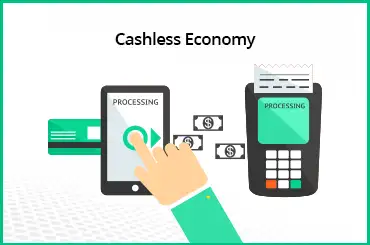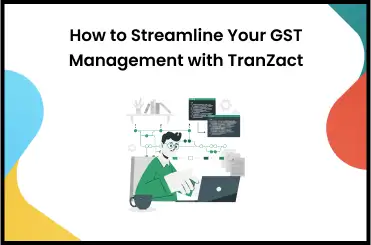Let's find out what is IGST in a simple way. IGST stands for Integrated Goods and Services Tax and is an important pillar of the Goods and Services Tax (GST); whose two other pillars are CGST and SGST. On July 1, 2017, GST became effective when GoI (Government of India) introduced GST to replace multiple taxations under the slogan, ‘One Nation, One Tax.' Before the onset of GST, a taxpayer had to file forms such as Central Excise, Service Tax, and State VAT.
Although GST is a one-multistage tax system, it is categorized according to intrastate or interstate transactions as CGST (Central Goods and Service Tax), SGST (States Goods and Service Tax), or IGST.
In this article, we will detail the aspects of IGST, what IGST means with an IGST example, and what businesses should know when it comes to IGST. Let's begin.
What Is IGST Tax in India?
IGST refers to the tax controlled by the IGST Act, where the central government is in charge of collecting taxes. Every interstate transaction of taxable goods or services would be subject to IGST levied by the Central Government. The full form of IGST is Integrated Goods and Services Tax.
The tax IGST charged by the government, emphasizes the cross-utilisation of credit wherein a transfer of funds is required between the respective accounts involved in the transaction. The central government then further divides these taxes among the corresponding states after collecting them.
Therefore, when one is required to define IGST or understand what is integrated GST, we can say that IGST tax is applicable when products or services are moved from one state to another.
The goods and service tax or GST is a revolutionary financial taxation scheme put into the Indian constitution to structure all company units equally into the database of tax-paying businesses. All indirect taxes are replaced with the goods and services tax.
Having understood what is IGST in India, let's look into the features of IGST.
Read Also - Best Warehouse Management Software
Features of IGST
Some of the most notable features of IGST include the following -
-
The Input Tax Credit (ITC) chain for interstate transactions remains unbroken.
-
There is no requirement for interstate sellers or buyers to pay tax upfront.
-
Taxes paid in the exporting state cannot be refunded since the ITC is used up while paying the tax.
-
IGST meaning Integrated Goods and Services Tax under GST, is an automated monitoring system.
-
Interstate dealers and central and state governments are the only entities involved in streamlining IGST.
-
The degree of compliance will significantly increase as dealers making interstate supplies will be electronically registered, and all communication with them will take place via email.
-
IGST is levied in transactions of both ‘Business to Business' and ‘Business to Consumer' categories and both these categories can be accounted for by the IGST model.
-
The IGST tax has a few more important components, including -
-
The central government and the state government of the state to which the good or service is provided (the state of consumption of the good or service), split the IGST revenue equally.
-
While paying IGST tax, one may claim the input tax credit from any of the four categories of GST.
Read Also - What Is Economic Order Quantity (EOQ) and Its Formula?
What Makes IGST Different From CST?
Before implementing the GST Act in 2017, interstate sales of goods and services were subject to Central Sales Tax (CST), governed by the CST Act of 1956.
In contrast to GST, the state government of the state where the products or services originated, is in charge of collecting CST income.
The significant distinctions between the IGST and CST are shown in the following table:
| IGST meaning, Integrated Goods and Services Tax | CST meaning, Central Sales Tax | |
|---|---|---|
| Applicability | The supply of goods and services across state lines. | Interstate supply of goods and services. |
| Who collects taxes? | IGST tax is charged by the central government. | The state government of the state of origin of the goods or services. |
| Benefitting authority | A portion of the revenue is divided equally between the central government and the state government of the state that consumes the goods or services. | State governments retain the revenue collected from taxes. |
| Input Tax Claim | It is possible to claim input tax against IGST, CGST, or SGST. | No input tax claim was allowed. |
IGST on Interstate Supply of Goods or Services
While the union government collects IGST, as GST is a consumption-based tax, the money is split equally between the union and the state government of the state where the products or services are consumed.
For all dealers exceeding a turnover of Rs. 20 lakhs or more, the limit applies to intra-state shipments, except for the northeastern states. Only dealers who are registered under the composition scheme and have annual sales below Rs. 1.5 crore are eligible for incentives inside the state.
IGST meaning Integrated Goods and Services Tax differs from previous GSTs because it applies to all interstate and intra-territorial transfers of goods and services.
Another thing to remember is that the IGST applies to transactions involving Special Economic Zones (SEZs) and that importing or exporting goods or services to or from an SEZ is regarded as an interstate transfer.
GST is applied to all types of supplies when making an interstate supply. The interstate trade turnover factor is not a factor in it. But as of Notification No. 10/2017 Integrated Tax dated October 13, 2017, the government has exempted from registering those who make interstate deliveries of taxable services and have an annual aggregate turnover of no more than Rs. 20 lakhs. This limit is Rs.10 lakhs when it comes to northeastern and special category states.
The GST Council's rules and regulations provide that from the due date to the payment date of taxes, an annual interest rate of 18% is applied to the GST tax that is owed.
Having understood how to define IGST, and what is IGST, let's understand the concept of how IGST is applied, with an example:
Ram, a Kolkata dealer, transfers Rs.10,000 in goods to Ajay, a merchant in Mumbai. If the goods are in the 18% GST bracket, Ram will collect from Ajay, an IGST of Rs.1800 (the product will cost Ajay Rs.11800), which he will then pay to the central government. The central government and the government of Maharashtra will then split this sum evenly, each receiving Rs. 900.
In the above sections, we understood who collects IGST, the IGST meaning, IGST is levied in transactions of which type, and the difference between IGST and CST. The next section will help you to understand more about the refund of IGST.
Read Also - What Is Production Management System?
Difference Between CGST, SGST, and IGST
The main differences between CGST (Central Goods and Services Tax), SGST (State Goods and Services Tax), and IGST (Integrated Goods and Services Tax) are as follows:
| CGST | SGST | IGST | |
|---|---|---|---|
| Applicability | Intra-state transactions within a single state in India. | Intra-state transactions within a single state in India. | Interstate transactions between two or more states in India. |
| Tax Collection | CGST is collected by the central government. | Collected by the respective state governments. | Collected by the central government and distributed to the respective states. |
| Benefitting Authority | Central government | State government | Central and state government. |
| ITC Adjustments Allowed | Input tax credit (ITC) for CGST can be utilized for offsetting liabilities under CGST or IGST; however, they cannot be utilized against SGST. | Input tax credit (ITC) for SGST can be utilized for offsetting liabilities under SGST or IGST; however, they cannot be utilized against CGST. | Input tax credit (ITCs) for IGST can be utilized for offsetting liabilities under CGST, SGST, or IGST. |
Refund of IGST
IGST stands for a tax that is levied on all interstate transfers of goods and services. In several circumstances, a person or a corporation may be qualified to request a refund of the GST they paid to the government.
In the following two scenarios, a GST refund may be requested:
Foreign Visitors
Foreign visitors known to be non-residents of India who visited India for up to six months may be entitled to a refund of the IGST. They can claim a refund of IGST that they paid on any goods or services obtained from Indian vendors while they were in the country.
Read Also - What Is Procure-to-Pay Process?
Offsetting Previously Paid Tax
If a person or business has already paid the applicable IGST under another tax heading (either in full or in part), they are eligible to get a refund of the amount they have already paid, i. e. Refunds would be issued to taxpayers who paid SGST or CGST rather than IGST.
In such cases, citizens are required to make a new deposit under the appropriate tax heading.
For instance, after paying the GST relevant to the sale of the finished items, the manufacturer who has already paid IGST on purchasing raw materials may demand a refund of the same amount.
According to GST Rules, an exporter is not eligible for a GST refund if:
-
They used the duty drawback option for the CGST, SGST, or IGST. However, if they have utilized the drawback on basic customs duty, they may request a refund of IGST.
-
They were able to purchase inputs for a discounted rate of 0.1%. Exports in such circumstances must be carried out using Letters of Undertaking (LUT) or bonds rather than with the payment of IGST.
-
They brought in inputs through the Advance Authorization program. Advance Authorization is an export incentive that permits the duty-free import of materials needed to make export-oriented products. The finished product must once again be exported under a LUT or bond rather than with the payment of IGST.
Read Also - Importance of Process Costing
Summarizing IGST and Simplifying Interstate Transactions
To understand the taxation that applies to transactions, whether it is CGST, SGST, or IGST, it is important to examine the intra-state and interstate supply points and know what is IGST.
If the supplier and buyer are located in the same state, it is considered an intra-state supply of goods or services. A seller in an intra-state transaction must collect both CGST and SGST from the buyer.
As far as interstate transactions are concerned, the seller is responsible for collecting the IGST from the buyer. An Interstate Supply is considered when the supplier and the place of supply are located in different states.
Likewise, the transactions are still interstate when an SEZ (Special Economic Zone) unit exports or imports goods or services and supplies goods or services to or by another SEZ unit.
Understanding and effectively complying with Integrated Goods and Services Tax (IGST) is crucial for businesses engaging in inter-state transactions. IGST simplifies the tax framework by providing a unified system and streamlining compliance.
By grasping the fundamentals of what is integrated GST, and leveraging IGST benefits, businesses can ensure smooth operations, minimize tax-related challenges, and contribute to a seamless and efficient interstate trade ecosystem.
FAQs on IGST
1. Which government collects IGST?
The Integrated Goods and Services Tax (IGST) is collected by the Indian central government, and it is then distributed among the concerned states. It is the responsibility of the central government to administer and manage the collection of IGST for interstate transactions.
2. What are CGST, SGST, and IGST?
Central Goods and Services Tax (CGST) is the tax imposed by the central government on the supply of goods and services within a state, while the tax levied by the states for the same, is known as State Goods and Services Tax (SGST). On the other hand, Integrated Goods and Services Tax (IGST) is levied in cases of interstate supply of goods and services. IGST is collected by the central government and distributed as per rules to concerned states. IGST also applies to imports.
3. When is IGST applicable?
IGST (Integrated Goods and Services Tax) is applicable when there is a supply of goods or services between two or more Indian states, as well as for import transactions. It ensures a unified and simplified tax system for interstate business transactions.
4. Can CGST be adjusted against IGST?
Yes, CGST (Central Goods and Services Tax) can be adjusted against IGST (Integrated Goods and Services Tax). CGST can only be adjusted against CGST or IGST liabilities, but not against SGST (State Goods and Services Tax) specifically.
5. What is the meaning of integrated goods and services?
Integrated goods and services are those goods and services which fall under the purview or the scope of the Integrated Goods and Services Tax (IGST). Within IGST, the tax revenue collected is further distributed between the Central and the State Governments.
6. What is an example of IGST?
An example of IGST or Integrated Goods and Services Tax is when a manufacturing company in one state sells its products to a customer in another state within India. The IGST collected by the center on the transaction is then distributed to the respective states as per the destination principle.
7. What is the difference between GST and IGST?
The main difference between GST (Goods and Services Tax) and IGST (Integrated Goods and Services Tax) lies in their scope and applicability. In the GST framework, an intrastate sale transaction attracts two taxes: State Goods and Services Tax (SGST), collected by the state, and Central Goods and Services Tax (CGST), collected by the central government. Conversely, an interstate sale transaction involves a single tax, the Integrated Goods and Services Tax (IGST), which is collected by the central government and distributed to the states involved in the transaction.
8. Who is liable to pay IGST?
In the context of interstate transactions in India, the liability to pay IGST (Integrated Goods and Services Tax) rests on the supplier or the entity making the supply of goods or services. The supplier is responsible for collecting IGST from the recipient and remitting it to the central government.
9. When is IGST applicable?
The tax IGST charged by the government stands for integrated goods and services tax. Every interstate transaction of taxable goods or services would be subject to IGST levied by the central government.
10. What is the meaning of IGST?
The IGST tax mechanism monitors interstate trade of goods and services and ensures that the State Goods and Services Tax (SGST) component accrues to the consumer state. This will maintain the integrity of the Input Tax Credit (ITC) chain in interstate supplies.
11. What is the difference between CGST & IGST?
One of the most prominent differences between IGST and CGST is that a CGST (Central Goods and Services Tax) or SGST (State Goods and Services Tax) is levied on intrastate (within a state) transactions, whereas an IGST is levied on imports, exports, and interstate sales. This is the primary IGST and CGST difference.
















